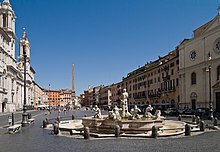Piazza

A piazza (Italian pronunciation: [ˈpjattsa]) is a city square in Italy, Malta, along the Dalmatian coast and in surrounding regions. The term is roughly equivalent to the Spanish plaza. In Ethiopia, it is used to refer to a part of a city.
When the Earl of Bedford developed Covent Garden - the first private-venture public square built in London - his architect Inigo Jones surrounded it with arcades, in the Italian fashion. Talk about the piazza was connected in Londoners' minds not with the square as a whole, but with the arcades.
In Britain piazza now generally refers to a paved open pedestrian space, without grass or planting, often in front of a significant building or shops. King's Cross Station in London is to have a piazza as part of its redevelopment. The piazza will replace the existing 1970's concourse and allow the original 1850's façade to be seen again. There is a good example of a piazza in Scotswood at Newcastle College.
In the United States, in the early 19th century, a piazza by further extension became a fanciful name for a colonnaded porch. Piazza was used by some, especially in the Boston[1] area, to refer to a verandah or front porch of a house or apartment.[2]
Piazza is a common last name for Italians and Italian-Americans. The name grew out of the region surrounding Venice. Populations of Piazza live in Calabria, Sicily, and Venice.
A central square just off Gibraltar's Main Street, between the Parliament Building and the City Hall officially named John Mackintosh Square is colloquially referred to as The Piazza.
[edit] See also
- List of city squares
- Piazza Della Transalpina - a piazza divided between Italy and Slovenia in the towns of Gorizia and Nova Gorica
- Plaza
- Town square
[edit] References
- ^ Boston University, "Boston English"
- ^ Piazza in the Oxford American Dictionary (2001).
| This Italy-related article is a stub. You can help Wikipedia by expanding it. |